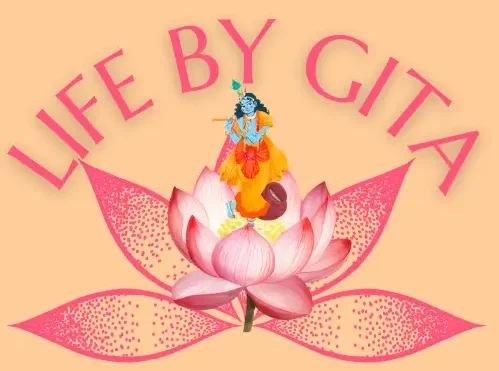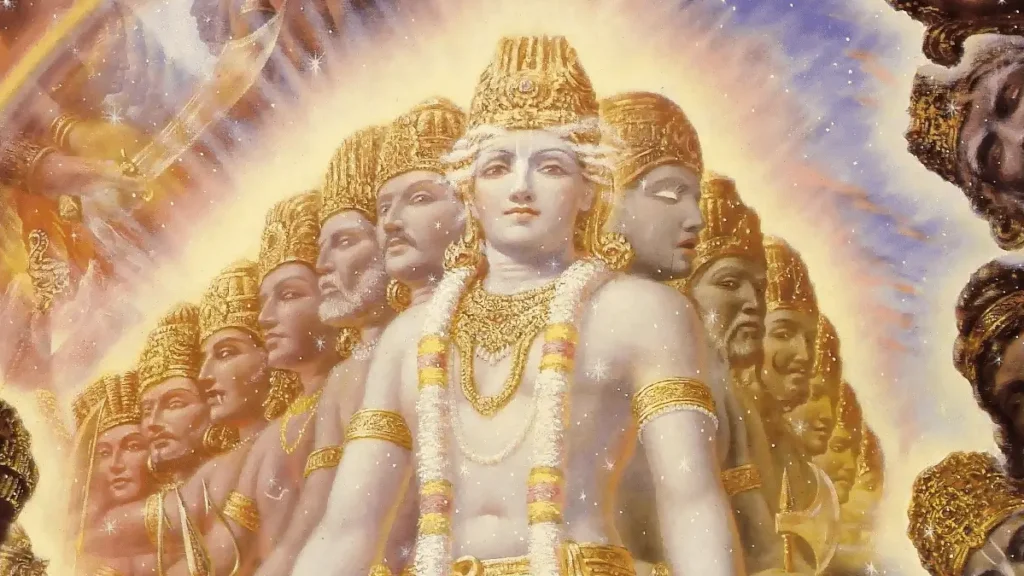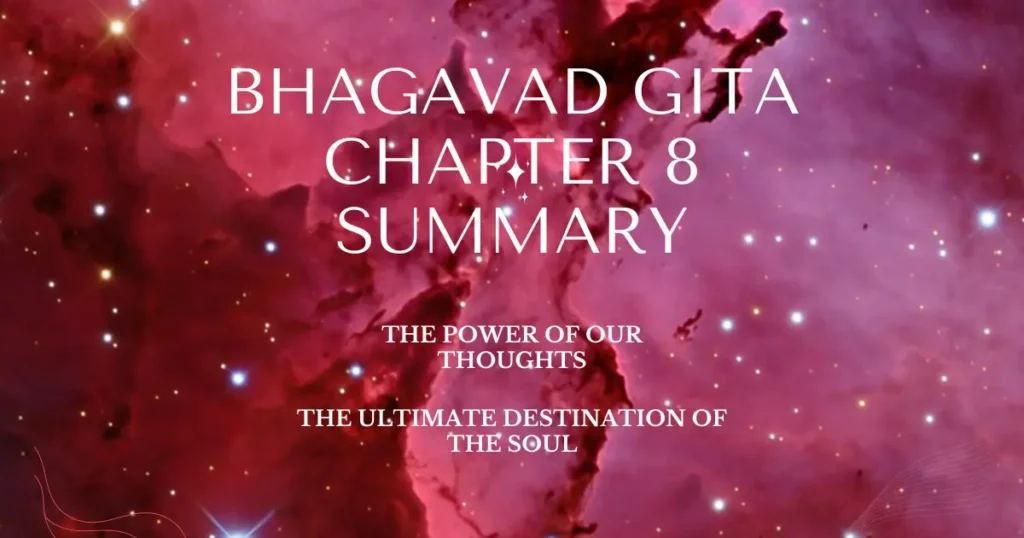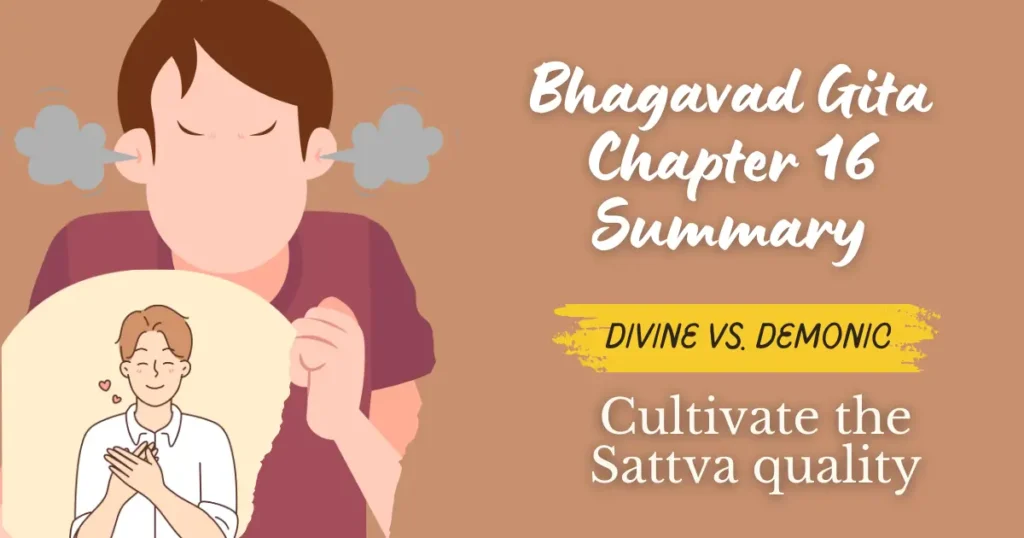
1. Introduction
In this article, we will explore the answer to the most frequently asked question: Can we eat non-veg if we are reading Bhagavad Gita?
The Bhagavad Gita, often referred to as the Gita, is a 700-verse sacred scripture that is part of the Indian epic Mahabharata. It is a conversation between Lord Krishna and Prince Arjuna, taking place on the battlefield of Kurukshetra. While the Gita primarily focuses on spiritual teachings and the path to self-realization—how we can understand ourselves better—it doesn’t really talk directly about what we should eat. But it does share some really good ideas and values (philosophical and ethical principles) that can help us decide.
2. Can we eat non-veg if we are reading Bhagavad Gita?
The Bhagavad Gita doesn’t explicitly say “no” to non-vegetarian food, but it does encourage us to think about the kind of food we eat.
Understanding Food Choices in Light of the Bhagavad Gita
Krishna says in Chapter 17 of the Bhagavad Gita that there are three types of foods that impact our consciousness, determining our inner and outer well-being. These are known as:
-
- Sattvic food
-
- Rajasic food
-
- Tamasic food
Sattvic food is pure, nourishing, and promotes a peaceful and harmonious mind. It consists of fruits, vegetables, grains, and dairy products obtained from ethical sources (Bhagavad Gita, chapter 17.7).
Rajasic food is excessively spicy, salty, or bitter. It stimulates passion, attachment, and desire, leading to restlessness and agitation (Bhagavad Gita, chapter 17.9).
Tamasic food is stale, impure, or obtained by unethical means. It brings inertia, ignorance, and dullness to the mind, leading to a decrease in vitality and clarity (Bhagavad Gita, chapter 17.10).
By consuming Sattvic food, one achieves a pure and balanced state of being, enabling spiritual growth and clarity of thought. Rajasic and Tamasic foods, on the other hand, hinder our spiritual progress by increasing the qualities of passion and ignorance within us, respectively.
The Main Question: What does Krishna say about non-veg or does non-veg come under tamasic?
The classification of meat or non-vegetarian food as tamasic food is rooted in various philosophical and spiritual beliefs, particularly in the Bhagavad Gita. According to these teachings:
i). Violence and Harm: Many followers interpret the act of taking an animal’s life for food as an act of violence, which is seen as contrary to the principle of ahimsa, or non-violence.
ii). Energy and Qualities: Meat is believed to carry certain energies or qualities that are associated with tamas, such as inertia, darkness, and heaviness. Consuming such foods may lead to a feeling of lethargy or sluggishness.
iii). Spiritual Growth: It’s thought that a diet predominantly consisting of tamasic foods, including meat, can hinder one’s spiritual progress by clouding the mind and creating an imbalance in the body’s energies.
Therefore, Krishna suggests in the Bhagavad Gita that one must strive to consume food that nourishes the body and mind while aligning with ethical principles. Remember, the food we consume greatly influences our thoughts, actions, and overall well-being. The theory is simple. If we eat pure food, our mind becomes pure, and by having a pure mind, we will be able to progress on our spiritual path easily.
3. Promoting Purity and Spiritual Growth
The answer to the question, Can we eat non-veg if we are reading Bhagavad Gita, can be understood by the teachings of the Bhagavad Gita. The Gita suggests that we should aim for food that brings purity and helps us grow spiritually. This idea lines up with “ahimsa,” which means not causing harm. Non-vegetarian food often involves causing harm to animals, which might not align with this principle. That’s why the food that is offered to Lord Krishna is also vegetarian.
Even the onion and garlic are not offered to Lord Krishna and all avatars of Lord Vishnu. The reason for this fact is a completely different concept from the concept that we are discussing right now. We will definitely explore it later. So, moving on to our topic, the following are the teachings of the Bhagavad Gita about food:
i). The Essence of Dharma
ii). Teaching of Equality
iii). Ahimsa: Non-Violence and Compassion
iv). Sattvic Diet: Nourishing Your Body and Spirit
v). Moderation and Balance: Living in Harmony
Understanding the Teachings of the Bhagavad Gita
i). The Essence of Dharma
The Bhagavad Gita really wants us to understand “dharma.” This is like our duty—what we should do to be good people in our community and the world. It’s not just about big things; even our food choices can be a part of this duty. So, we might choose to eat in a way that we feel is responsible and good for ourselves, others, and the world around us.
In simple words, the Bhagavad Gita encourages us to think about our responsibilities and what we can do to make the world a better place. This includes the food we choose to eat, which can be part of our duty towards ourselves and the environment.
ii). Teaching of Equality
Krishna, in the Bhagavad Gita, imparts a deep lesson that every living being deserves love and respect. He emphasizes the idea that all creatures are equal. Krishna says in the Bhagavad Gita, “Even if one kills animals for sacrifice, the act of killing creates bad karma. Therefore, it is better to offer a vegetarian sacrifice.” (Bhagavad Gita, 17.26–27).
If someone were to sacrifice animals as part of a ritual, Krishna teaches that the act of taking a life creates negative energy, or “bad karma.” Therefore, he suggests a more compassionate approach: offering a vegetarian sacrifice instead. This shows us that even in ancient times, the importance of kindness and empathy towards all living beings was recognized.
iii). Ahimsa: Non-Violence and Compassion
Krishna places great emphasis on practicing “ahimsa,” which means not causing harm or violence. He encourages us to treat all living creatures with gentleness and care. This principle extends not only to our actions but also to what we choose to consume. Many interpret this as an endorsement of a vegetarian lifestyle.
iv). Sattvic Diet: Nourishing Your Body and Spirit
The Bhagavad Gita suggests a way of eating that’s known as a “Sattvic” diet. This kind of diet is all about choosing foods that are really good for you, inside and out. It’s like giving your body and mind the best kind of fuel to help you think clearly and grow spiritually. 
As mentioned above, it is made up of things like fruits, vegetables, grains, nuts, and dairy products. These are considered to be pure and wholesome foods. Many people who follow the teachings of the Gita decide to eat this way because it’s in line with what the Gita teaches about taking care of yourself, both physically and spiritually.
In simple terms, a Sattvic diet is like picking the healthiest and most nurturing foods to help your body and soul thrive. It’s like giving yourself the best chance to feel good and grow in a positive way.
The Goodness of Vegetarian Food
In Chapter 17, Verse 7, Krishna states, “Even the foods that increase life and purify one’s existence—those foods in the mode of goodness—are to be eaten by those whose aim is to advance in spiritual life”. It means that Krishna advises those who are on a spiritual journey to choose foods that promote a healthy and pure life. This refers to vegetarian foods that are considered to be in the “mode of goodness.” These are foods that are nourishing not just for the body but also for the soul.
In simpler terms, the Bhagavad Gita is guiding us to be kind and considerate, not only in our actions but also in what we choose to eat. It teaches us that a diet rooted in compassion and non-violence is not only good for our physical health but also for our spiritual well-being.
v). Moderation and Balance: Living in Harmony
The Bhagavad Gita teaches us an important lesson about how to live a balanced and good life. It says that in everything we do, including what we eat, it’s best to keep things in balance. This means not going too much in one direction or the other, but finding a middle ground.
Imagine it like this: if you swing on a swing, you want to go back and forth, not too high or too low. That’s like finding the right balance in life.
When it comes to food, the Gita suggests that we should eat a mix of different things. Not just one type, but a little bit of everything that is good for us—for our physical as well as spiritual growth. This way, our body gets all the right stuff it needs to stay healthy and strong.
So, remember, balance is the key! It’s about finding that sweet spot in everything we do, including how we nourish ourselves.
Remember, these teachings are not just about ancient practices; they hold relevance in our lives today. They inspire us to be mindful of our choices, to show love and respect to all living beings, and to cultivate a sense of compassion in our hearts.
4. Evolution of Beliefs: Growing on Our Journey
As we go through life, our thoughts and beliefs can change. This is especially true on our spiritual journey. For example, someone who used to eat both vegetarian and non-vegetarian foods might decide to switch to a vegetarian or even vegan diet when they learn more about the teachings of the Gita because the same question, Can we eat non-veg if we are reading Bhagavad Gita?, may arise in the mind during the spiritual journey if someone is reading the Bhagavad Gita.
This shift in diet might come from a deeper understanding of the Gita’s wisdom, which emphasizes compassion and kindness towards all living beings. So, as we learn and grow, our beliefs and actions may change too, leading us towards a lifestyle that aligns more closely with our spiritual path. It’s like realizing new ways to live in harmony with the world around us.
5. Conclusion
In conclusion, the Bhagavad Gita does not explicitly mandate a specific dietary choice. It places more emphasis on the principles of Dharma, Ahimsa, and Spiritual Growth. Therefore, whether one chooses to eat non-veg while reading the Bhagavad Gita is a personal decision that should align with their understanding of these principles. The Bhagavad Gita only mentioned the three types of foods according to its principles of Duty (Dharma), Non-violence, and Spiritual Growth. The choice is yours; what should be your Duty in choosing your diet?
It can be a question of debate because many people who are the disciples of Lord Krishna and follow the Bhagavad Gita do not eat non-vegetarian foods and strictly follow the vegetarian diet. So, I am stopping here by leaving a question for you. Please answer if you can in the comment box.
If you want spiritual growth, non-violence in your life, and follow the principles of the Bhagavad Gita, but you eat non-vegetarian (tamasic food), which includes violence before coming to you, which is not aligned with the principles of the Bhagavad Gita (because the food we eat not only influences our body but also our mind and soul), then will you be able to fully grasp the core teachings of the Bhagavad Gita and feel the divine power by progressing in your spiritual path?
Must read: How can we control our mind according to Bhagavad Gita?
6. FAQs
1. Does Bhagavad Gita allow eating non veg?
The Bhagavad Gita doesn’t explicitly allow or forbid eating non-vegetarian foods. It emphasizes values like compassion and nonviolence. It leaves the choice up to individuals by mentioning the types of foods. Ultimately, the most important factor is practicing mindfulness and living a life focused on selfless service, devotion, and spiritual growth. The Gita encourages us to prioritize the purity of our thoughts and actions, which in turn guides our choices, including food preferences.
2. Can a person following a non-vegetarian diet still practice the teachings of the Bhagavad Gita?
Yes, a person following a non-vegetarian diet can still practice the teachings of the Bhagavad Gita. It is more important to live by the principles of duty, compassion, and spiritual growth.
3. What food is allowed in Bhagavad Gita?
Gita encourages moderation, balance, and eating food that is pure, wholesome, and conducive to a peaceful state of mind. The Gita explains that sattvic (pure) food promotes clarity, strength, longevity, happiness, satisfaction, and spiritual growth. It includes a variety of fruits, vegetables, grains, nuts, and dairy products. These qualities aren’t found in foods that are rajasic (stimulating) or tamasic (inert and impure).
4. How does one find the right balance in their dietary choices according to the Bhagavad Gita?
The Bhagavad Gita advises moderation and balance in all aspects of life, including diet. It suggests avoiding extremes and finding a nourishing, balanced approach to food that is good for physical, mental, and spiritual growth.
5. Can dietary preferences change over time in accordance with one’s spiritual journey?
Yes, as individuals progress on their spiritual journey, their beliefs and practices, including dietary choices, may evolve. This may lead to a shift towards a diet that aligns more closely with their understanding of the Gita’s teachings.
Further reading
You can find more details about the Bhagavad Gita at the website – Bhagavad Gita as it is
If you have any question or feedback, feel free to write a comment in the comment box below.












